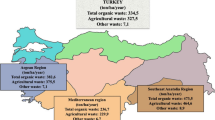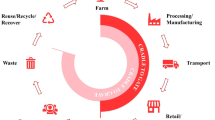Abstract
Purpose
Agro-food systems are involved with considerable environmental impacts. Tomato as an important vegetable crop is processed into some products such as puree, ketchup, and paste. This study aimed to investigate the environmental impacts of tomato puree production considering its entire life cycle, including tomato cultivation, processing, packaging, and transportation, to identify the hotspots and potential improvements for each stage to reduce environmental burdens.
Methods
The primary data were collected from the processing plant located in Urmia County, Iran, and 28 tomato growers which provide tomato to processing plant using a face-to-face questionnaire. The source for secondary data was the Ecoinvent, LCA Food DK, and IDMAT 2001 databases. The functional unit was considered as 500 g tomato puree packaged in a steel can with a plastic cap. The environmental impacts were investigated using the CML 2 baseline method.
Results and discussions
Results showed that packaging is the most important contributor to all impact categories except acidification (AC) and eutrophication (EP) in which tomato cultivation was indicated as the hotspot. In the cultivation phase, electricity and N-based fertilizers were indicated as the major contributors to most impact categories. Diesel fuel and natural gas were the hotspots in the processing phase.
Conclusions
Based on the results, packaging and cultivation phases have enough potential to reduce environmental impacts during puree production. It can be realized through applying materials that are involved with negligible environmental burdens during their production for packaging and improving irrigation systems for reducing electricity as a major hotspot in cultivation phases. Also, soil analysis would be helpful to determine the amounts and types of required fertilizers.




Similar content being viewed by others
References
Andersson K, Ohlsson T, Olsson P (1998) Screening life cycle assessment (LCA) of tomato ketchup: a case study. J Clean Prod 6(3):277–288
Anonymous (2017) FAOSTAT, Food and Agriculture Organization Statistics. http://www.fao.org/faostat/en/#data/QC; <http://www.fao.org/faostat/en/>
Bacenetti J, Duca D, Negri M, Fusi A, Fiala M (2015) Mitigation strategies in the agro-food sector: the anaerobic digestion of tomato puree by-products. An Italian case study. Sci Total Environ 526:88–97
Boguski TK, Hunt RG, Cholakis JM, Franklin WE (1996) LCA methodology. In: Curran MA (ed) environmental life-cycle assessment. Library of Congress Cataloging-in-publication Data, pp 15-33
Bolliger R, Bauer C (2007) Wasserkraft. Sachbilanzen von Energiesystemen (Ecoinvent report no. 6). Swiss Centre for LCI, Dübendorf and Villigen, Switzerland
Braschkat J, Patyk A, Quirin M, Reinhardt GA (2004) Life cycle assessment of bread production-a comparison of eight different scenarios. DIAS report, 9
Buttery RG, Teranishi R, Ling LC, Turnbaugh JG (1990) Quantitative and sensory studies on tomato paste volatiles. J Agric Food Chem 38(1):336–340
Calderón LA, Iglesias L, Laca A, Herrero M, Diaz M (2010) The utility of life cycle assessment in the ready meal food industry. Resour Conserv Recycl 54:1196–1207
Cellura M, Longo S, Mistretta M (2012) Life cycle assessment (LCA) of protected crops: an Italian case study. J Clean Prod 28:56–62
Cichorowski G, Joa B, Hottenroth H, Schmidt M (2015) Scenario analysis of life cycle greenhouse gas emissions of Darjeeling tea. Int J Life Cycle Assess 20(4):426–439
De Klein C, Novoa RSA, Ogle S, Smith KA, Rochette P, Wirth TC, McConkey BG, Mosier A, Rypdal K, Walsh M (2006) N2O emissions from managed soils, and CO2 emissions from lime and urea application. IPCC Guidelines for National Greenhouse Gas Inventories, Prepared by the National Greenhouse Gas Inventories Programme, Institute for Global Environmental Strategies (IGES), Japan
Dechmi F, Playán E, Faci JM, Tejero M (2003a) Analysis of an irrigation district in northeastern Spain: I: characterisation and water use assessment. Agric Water Manag 61:75–92
Dechmi F, Playán E, Faci JM, Tejero M, Bercero A (2003b) Analysis of an irrigation district in northeastern Spain: II. Irrigation evaluation, simulation and scheduling. Agric Water Manag 61:93–109
Del Borghi A, Gallo M, Strazza C, Del Borghi M (2014) An evaluation of environmental sustainability in the food industry through life cycle assessment: the case study of tomato products supply chain. J Clean Prod 78:121–130
EPA-Environmental Protection Agency (1998) Emission factor documentation for AP-42 Section 1.4-Natural gas combustion, Technical support division, Office of Air Quality Planning and Standards, Research Triangle Park, NC. ‹http://www3.epa.gov/ttnchie1/ap42/ch01/bgdocs/b01s04.pdf ›
European Commission (2011) Roadmap to a resource efficient Europe
Faist Emmenegger M, Heck T, Jungbluth N (2007) Erdgas. Sachbilanzen von Energiesystemen (Ecoinvent report no. 6). Swiss Centre for Life Cycle Inventories, Dübendorf and Villigen, Switzerland
Farahani SS, Asoodar M (2017) Life cycle environmental impacts of bioethanol production from sugarcane molasses in Iran. Environ Sci Pollut Res 24:22547–22556
Guinée JB, Gorrée M, Heijungs R, Huppes G, de Koning KRA, Wegener Sleeswijk A (2001) Handbook on life cycle assessment. Operational Guide to the ISO Standards. Kluwer, Dordrecht, the Netherlands
Intergovernmental Panel on Climate Change (IPCC) (1996) In: Houghton JT, Meira Filho LG, Lim B, Treanton K, Mamaty I, Bonduki Y, Griggs DJ, Callender BA (eds) Revised 1996 IPCC guidelines for national greenhouse gas inventories. IPCC/OECD/IEA, Paris
ISO 14040 (2006) Environmental management: life cycle assessment: principles and framework. ISO, Geneva
ISO 14044 (2006) Environmental management—life cycle assessment—requirements and guidelines. ISO, Geneva
Khanali M, Shahvarooghi Farahani S, Shojaei H, Elhami B (2017) Life cycle environmental impacts of saffron production in Iran. Environ Sci Pollut Res 24(5):4812–4821
Khoshnevisan B, Rafiee S, Omid M, Mousazadeh H, Clark S (2014) Environmental impact assessment of tomato and cucumber cultivation in greenhouses using life cycle assessment and adaptive neuro-fuzzy inference system. J Clean Prod 73:183–192
Kouchaki-Penchah H, Sharifi M, Mousazadeh H, Zarea-Hosseinabadi H, Nabavi-Pelesaraei A (2016) Gate to gate life cycle assessment of flat pressed particleboard production in Islamic Republic of Iran. J Clean Prod 112:343–350
Lecina S, Playán E, Isidoro D, Dechmi F, Causape J, Faci JM (2005) Irrigation evaluation and simulation at the irrigation district V of Bardenas (Spain). Agric Water Manag 73(3):223–245
Manfredi M, Vignali G (2014) Life cycle assessment of a packaged tomato puree: a comparison of environmental impacts produced by different life cycle phases. J Clean Prod 73:275–284
Nabavi-Pelesaraei A, Rafiee S, Mohtasebi SS, Hosseinzadeh-Bandbafha H, Chau KW (2019) Assessment of optimized pattern in milling factories of rice production based on energy, environmental and economic objectives. Energy 169:1259–1273
Nemecek T, Kägi T, Blaser S (2007) Life cycle inventories of agricultural production systems. Final report Ecoinvent v2.0 no.15. Swiss Centre for Life Cycle Inventories, Duebendorf, Zurich, Switzerland
Nikkhah A, Emadi B, Firouzi S (2015) F sustain. Energy Technol Assess 12:10–14
Notarnicola B, Hayashi K, Curran MA, Huisingh D (2012) Progress in working towards a more sustainable agri-food industry. J Clean Prod 28:1–8
Pishgar-Komleh SH, Akram A, Keyhani A, Raei M, Elshout PMF, Huijbregts MAJ, van Zelm R (2017) Variability in the carbon footprint of open-field tomato production in Iran-a case study of Alborz and East-Azerbaijan provinces. J Clean Prod 142:1510–1517
Playán E, Slatni A, Castillo R, Faci JM (2000) A case study for irrigation modernisation: II scenario analysis. Agric Water Manag 42:335–354
Rajaeifar MA, Akram A, Ghobadian B, Rafiee S, Heidari MD (2014) Energy-economic life cycle assessment (LCA) and greenhouse gas emissions analysis of olive oil production in Iran. Energy 66:139–149
Romero-Gámez M, Suárez-Rey EM, Antón A, Castilla N, Soriano T (2012) Environmental impact of screenhouse and open-field cultivation using a life cycle analysis: the case study of green bean production. J Clean Prod 28:63–69
Roy P, Nei D, Okadome H, Nakamura N, Orikasa T, Shiina T (2008) Life cycle inventory analysis of fresh tomato distribution systems in Japan considering the quality aspect. J Food Eng 86(2):225–233
Soheili-Fard F, Kouchaki-Penchah H, Raini MGN, Chen G (2018) Cradle to grave environmental-economic analysis of tea life cycle in Iran. J Clean Prod 196:953–960
Verones F, Pfister S, Van-Zelm R, Hellweg S (2016) Biodiversity impacts from water consumption on a global scale for use in life cycle assessment. Int J Life Cycle Assess 22(8):1247–1256
World Water Assessment Programme (2009) The United Nations world water development report 3: water in a changing world. UNESCO and London: Earthscan, Paris
Yahyaoui I, Tadeo F, Segatto MV (2016) Energy and water management for drip-irrigation of tomatoes in a semi-arid district. Agric Water Manag 183:4–15
Zarei MJ, Kazemi N, Marzban A (2017) Life cycle environmental impacts of cucumber and tomato production in open-field and greenhouse. J Saudi Soc Agric Sci. https://doi.org/10.1016/j.jssas.2017.07.001
Acknowledgments
The authors would like to thank the company’s personnel for cooperation and giving the data.
Funding
The authors would like to thank the Ramin Agriculture and Natural Resource University of Khuzestan for financial support.
Author information
Authors and Affiliations
Corresponding author
Additional information
Responsible editor: Thomas Jan Nemecek
Publisher’s note
Springer Nature remains neutral with regard to jurisdictional claims in published maps and institutional affiliations.
Rights and permissions
About this article
Cite this article
Shahvarooghi Farahani, S., Soheilifard, F., Ghasemi Nejad Raini, M. et al. Comparison of different tomato puree production phases from an environmental point of view. Int J Life Cycle Assess 24, 1817–1827 (2019). https://doi.org/10.1007/s11367-019-01613-x
Received:
Accepted:
Published:
Issue Date:
DOI: https://doi.org/10.1007/s11367-019-01613-x




